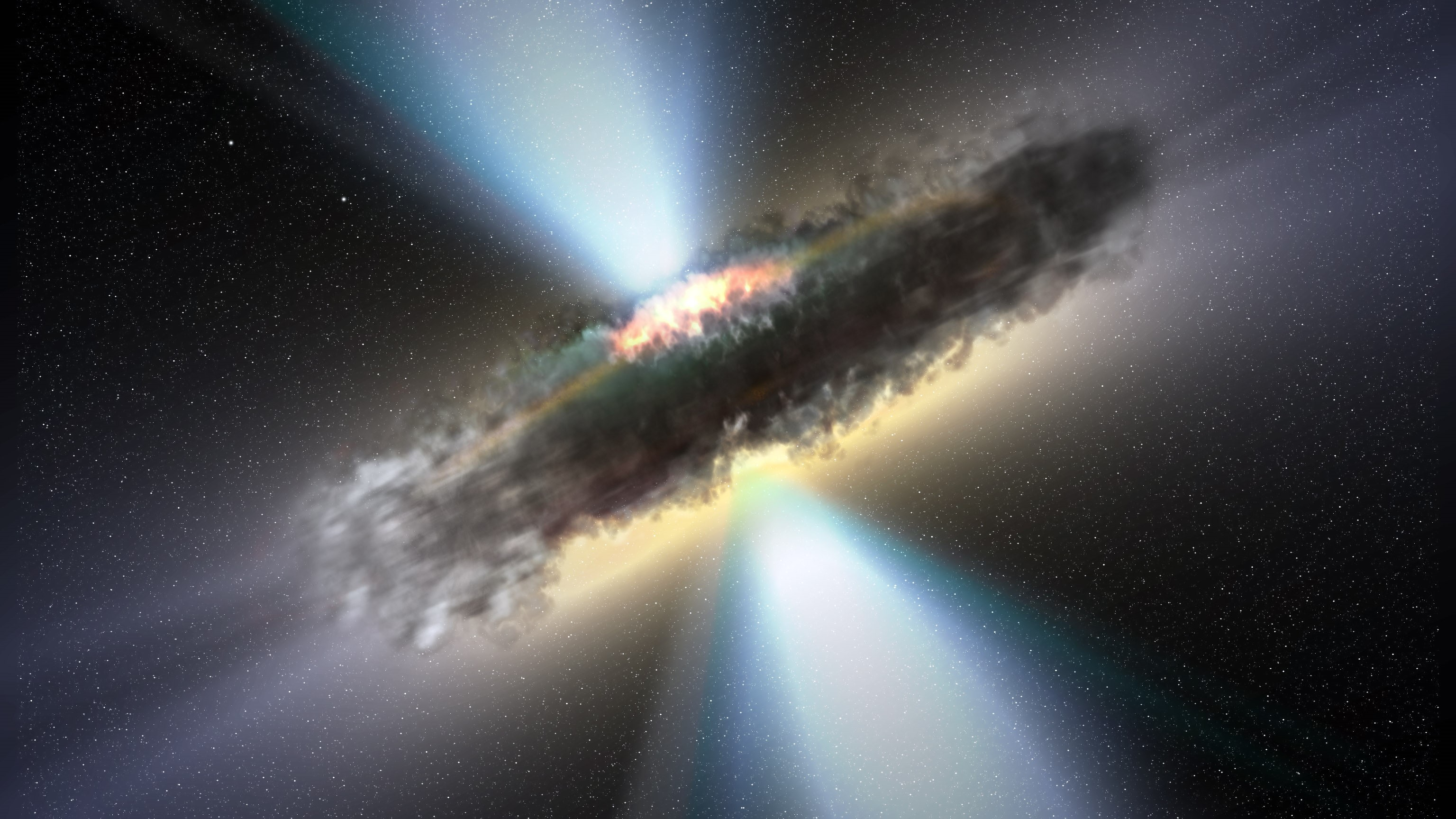
Greedy supermassive black holes blasting out powerful light may be hidden at the heart of star-birthing galaxies. The discovery could help researchers better understand how galaxies grow.
Supermassive quasars powered by black holes are responsible for some of the most powerful and bright emissions of light in the universe, often outshining the combined light of every star in the galaxy around them. These emissions are created when black holes heat and rip apart surrounding matter, consuming some and channeling some into near-light-speed jets launched from their poles.
Yet despite this activity, it may be difficult to see the quasars from Earth. These feeding cosmic titans — and the radiation blasted out from around them — can be obscured by the gas and dust of galaxies surrounding them. Previously, scientists suggested the only way galaxies could effectively hide quasars was with a thick ring of dust, or a torus, close to the supermassive black hole that is feeding it. This new research shows there is another way for some galaxies to "bury" quasars with more distant material.
"The light coming from quasars also interacts with material further out in the host galaxy, whereas before we thought most of this interaction was with material feeding the central super black hole," research leader Carolina Andonie, a scientist with Durham University's center for extragalactic astronomy in the U.K., told Space.com. "This quasar-blocking dust was actually a surprise. We were not expecting to observe this."
Related: Very Large Telescope surprisingly finds exoplanet lurking in 3-body star system
To discover that more far-out clouds of dust can shroud quasars, the Durham-led team set about observing a sample of "dusty quasars" with the Atacama Large Millimeter Array (ALMA) in northern Chile. ALMA is an array of 66 telescopes capable of peering through the dust of distant objects using long wavelengths of light, such as infrared or heat-emitting wavelengths.
Using the array, the team found that these dusty quasars tend to be located in galaxies that are undergoing extreme bouts of star formation, which are so-called "starburst galaxies."
"The main finding of our research was that these quasars that are obscured by really large amounts of gas and dust are more likely to live in these starburst galaxies, which are galaxies forming a huge amount of stars — more than 100 or even 200 stars like our sun per year," Andonie said. "In these systems, the galaxy itself has a very large amount of gas and dust that is creating stars, and this doesn't allow the light coming from the quasar to escape."
Gas and dust can be as thick and dense as a wall, she added. Similar to how a laser pointer directed at a wall allows no light to shine through the wall, this dense material blocks visible light emission coming from the quasar. Thus, the only way to see these quasars is in infrared light or by X-ray emissions, though there are cases when even highly energetic X-rays can't escape.

The connection between starburst galaxies and buried quasars is strongest when the central quasar is feeding rapidly and thus undergoing an intense growth spurt. Thus, the buried quasars and their galaxies may actually represent an early galactic evolutionary stage during which young galaxies are rich with cold, dense gas and dust, which fuels high rates of star formation and black hole growth.
The team's findings suggest there may be more quasars in the universe than believed. Many star-forming stars may be harboring active supermassive black holes at their hearts and blocking their emissions of the quasars, the study suggests.
"One of the key results of the research is that these galaxies forming a lot of stars are probably hiding quasars at their center," Andonie said. "It is possible that some of these galaxies that we didn't think have quasars at their center are hiding a quasar that we just can't see in optical light."
The team conducted this study by observing 600 dusty quasars. More work is on deck To confirm the results and to better connect dusty quasars with starburst galaxies, Andonie said the group intends to observe as many as 60,000 quasars.
"I am in the last year of my Ph.D., so it was really nice to find these incredible results because it gives me many ideas about how I can continue my research after the Ph.D.," Andonie added.
A paper detailing the team's research was published Oct. 6 in the Monthly Notices of The Royal Astronomical Society.







